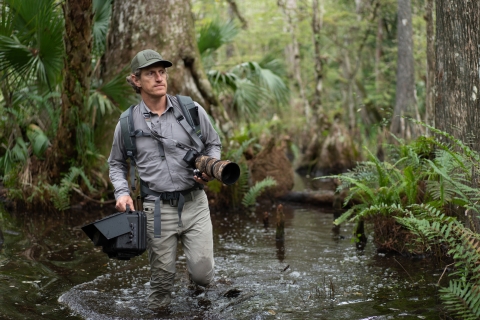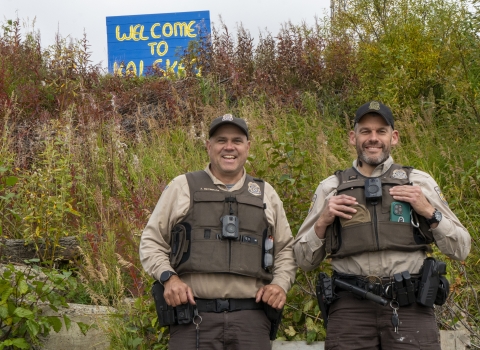Easy and inexpensive digital cameras with the proliferation of sharing photos on social media have spurred a boom in wildlife photographers. Unfortunately, this can lead to crowds of enthusiasts pressing into refuges, overrunning parks and preserves, trampling habitat, and threatening the very species they are photographing.
The National Wildlife Refuge System Improvement Act of 1997 put wildlife first. Photography is one of the “Big 6” wildlife-dependent recreational uses on refuges in addition to hunting, fishing, wildlife observation, interpretation, and education. But these uses must not be at the expense of the wildlife.
Carlton Ward Jr. is an award-winning conservation photographer and National Geographic Explorer. Ward’s work embodies ethical consideration and practices. An eighth-generation Floridian, his spectacular wildlife images have inspired the public and helped lead to legislation that designates interconnected natural areas for wildlife over almost 18 million acres in Florida.
His issue-driven photography and vision have taken persistence and patience over years to capture. It takes a body of quality work, and extensive partnerships, to persuade the public and influence action. A series of expeditions starting in 2012 began by following the Florida black bear’s migration through the state. Subsequent trips explored the proposed corridor on public and private lands. Photos, videos, and media campaigns advocated for a connected Florida.
The federally endangered Florida panther is the ambassador for his current project, Path of the Panther. A gorgeous and impeccably lit photograph of a Florida panther crossing a stream took Ward five years to capture with camera traps. Ward sets up remote cameras and flashes on game trails, where even in the best locations a panther might pass by only once in one or two months.
Ward must obtain special use permits for most of his photo sites. For every location he consults with wildlife biologists at the Florida Fish and Wildlife Conservation Commission and U.S. Fish and Wildlife Service and adopts measures to ensure he won’t harm the wildlife or its habitat. Each of his professional camera traps is paired with a secondary trail camera to monitor the behavior of animals passing to ensure the shutter sound and white lights don’t disturb them.
Ward is a founding fellow of the International League of Conservation Photographers, which strives to “support environmental and cultural conservation through ethical photography and filmmaking.” Members must maintain the highest ethical standards in photography and encourage others to do the same.
The organization’s key principles:
Minimize negative impacts
We commit to conscientiously minimize any negative impact we may have on the world, the areas where we work, and the wildlife and people we photograph or film, either directly at the time of taking images, how our images are used, or as a consequence of the example we set to others and/or the perceptions we create. Consideration for the welfare and conservation of humans, animals, fungi, plants as well as the integrity of the landscapes and waterscapes in which we work, will be placed above all else. When dealing with wildlife, priority will be given to minimizing any negative physical, emotional, or behavioral impacts we may have.
Honesty, authenticity, and accuracy
Members commit to authenticity, accuracy, and transparency in image capture, post-production, portrayal, captioning, and storytelling.
Respectfulness
We commit to behaving respectfully to all with whom we work, engage and come in contact with, whether human, animal, fungi, plant, or other organisms as well as the landscapes and waterscapes in which we work. When working with Indigenous people and local cultures, we will respect and accurately represent their cultural values and traditions. In all places we work, we will familiarize ourselves with, and follow, all appropriate laws, regulations, and customs.
Integrity and Professionalism
Our ability to achieve our conservation goals is inextricably linked to our integrity and professionalism. Our behavior reflects the integrity of our work, represents the work of all iLCP members and iLCP as an organization, and influences other photographers and filmmakers worldwide.
Accountability
We commit to hold ourselves and our organization accountable to strict adherence to these Ethical Principles.
International League of Conservation Photographers is comprised of some of the best photographers in the world, who demonstrate that the perfect image can be captured without harm to the subject or its habitat. Carlton Ward Jr. is a conservationist first. “Photography is an art tool to inspire action for conservation. If I went blind, I would be a biologist or work in policy as it affects conservation,” he said. For Ward, capturing the photographs is the beginning of the real conservation work. With the Path of the Panther project mostly complete, Ward and his team will now use a book, exhibit, film and educational curriculum to comprise the next stage of their advocacy. He is collaborating with the National Geographic Society, The Nature Conservancy, and many partners to conduct tours, media events, and openings early next year to further raise public awareness and garner support. All for the protection of the last open, connected wild lands in Florida.






